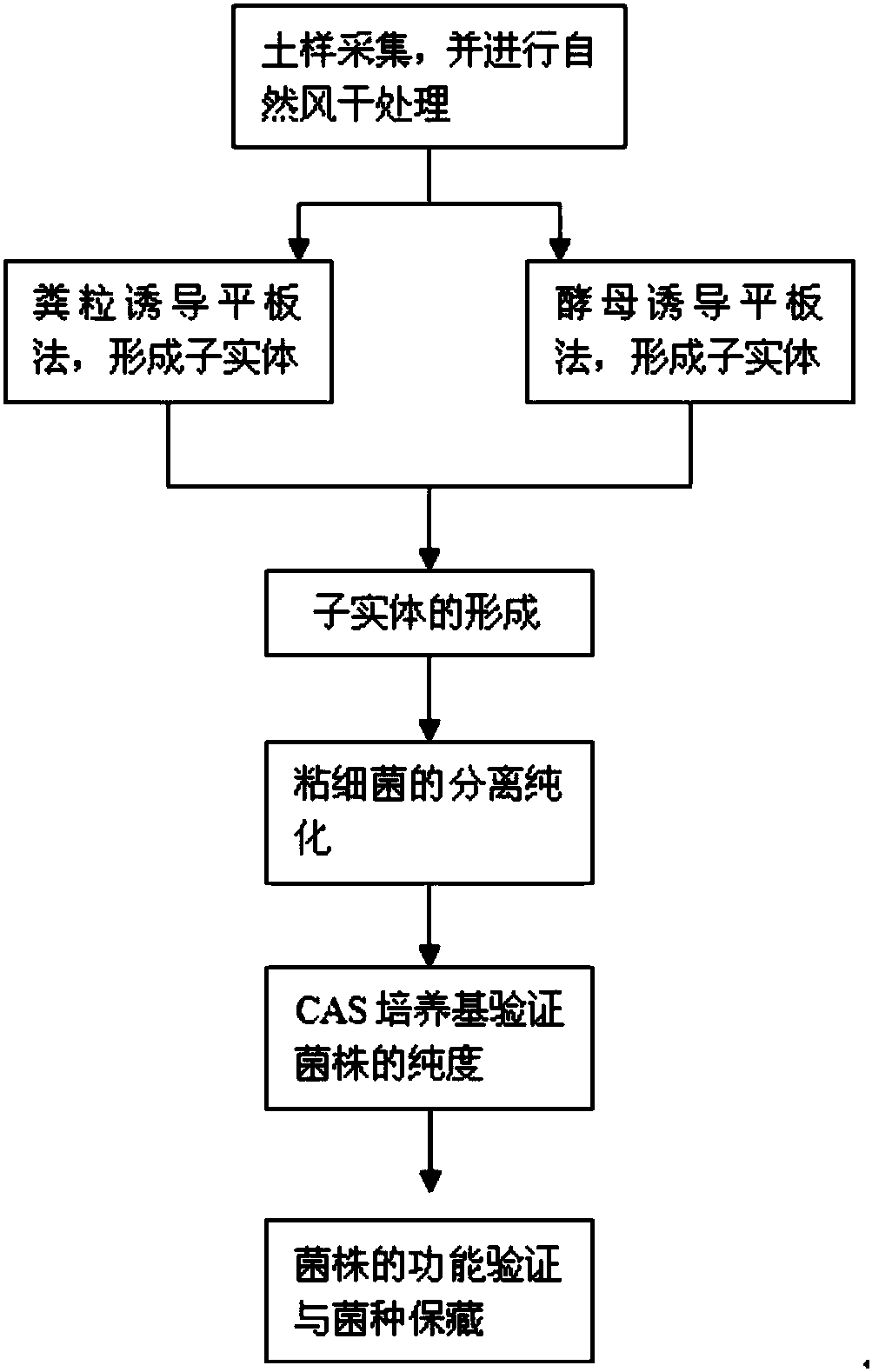Myxococcus stipitatus preying on plant pathogenic bacteria and application thereof in biological control of bacterial diseases
A technology of plant pathogenic bacteria and pathogenic bacteria, applied in the field of applied microbiology, can solve problems such as differences in antibacterial effects, and achieve the effect of huge application potential
- Summary
- Abstract
- Description
- Claims
- Application Information
AI Technical Summary
Problems solved by technology
Method used
Image
Examples
Embodiment 1
[0031] Embodiment 1. Separation and purification of bacterial strains
[0032] 1.1 After the sample is collected, let it dry naturally at room temperature (to reduce the pollution of mold and miscellaneous bacteria).
[0033] Soil samples collected from Anhui and other places were air-dried naturally at room temperature.
[0034] 1.2 Induction of myxobacteria fruiting bodies
[0035] 1.2.1 Fecal particle induction plate method: Put about 20 grams of air-dried soil samples in a petri dish, half bury 3-4 sterilized rabbit feces on the surface of the soil samples, add 25 μg / ml ether sterilized put After soaking for 6 hours with Cycloheximide (25mg / ml) or Carbendazim (30mg / l), pour off the residual liquid, incubate at 30°C, and observe the formation of fruiting bodies on the feces ball after 48 hours.
[0036] 1.2.2 Yeast induction plate method: use WCX (cycloheximide 25mg / ml) medium as the basic medium, pour it into a sterile plate, draw a cross line with yeast on the surface of ...
Embodiment 2
[0047] Example 2. Identification of bacterial strains
[0048] 2.1 Morphological features
[0049] The isolated and screened myxobacteria BS were negative by Gram staining. Observation under the oil microscope by crystal violet staining revealed that the shape of the single bacterium was rod-shaped, without flagella, and both ends were transparent. Layer mucus layer; find that this bacterial strain has colony effect in the process of growth by light microscope 10 * observation, and growth late stage bacterium colony gathers together to form fruiting body ( figure 2 ).
[0050] 2.2 Identification
[0051] The 16S rDNA gene sequence of the strain was obtained by amplifying the 16S rDNA of the strain by PCR, and logged in NCBI (www.ncbi.nlm.nih.govPblastP) to obtain the 16S rDNA sequence of a typical strain similar to the experimental strain. The obtained sequencing results were compared with the known sequences in the database using BLAST software in the GenBank database. Th...
Embodiment 3
[0052] Example 3. Research on the predation effect of Myxococcus stipitatus BS on plant pathogenic bacteria 3.1 Research on the predation effect of strain BS on various plant pathogenic bacteria.
[0053] Ea, Dickeya fangzhongdai, Dickeya chrysanthemi, Dickeya solani, Pcc, RS were inoculated in LB liquid medium (tryptone 1%, NaCl 1%, yeast extract 0.5%), cultivated overnight at 30°C, centrifuged at 8000rpm for 3min, collected the bacteria, and used Resuspend in sterile water to OD 600 for 10. Drop it into TPM (10mM Tris-HCl [pH7.6], 1mM KH2PO4 [pH 7.6], 8mM MgSO 4 )) Blow dry on a solid plate for later use. Inoculate strain BS (CCTCCM2017496) into CYE liquid medium (Casitione 1%, Yaest extract 0.5% MgSO 4 ·7H 2 (0.1%pH 7.2-7.6), cultivated at 30°C for 2 days, centrifuged at 8000rpm for 3min, collected the thallus, resuspended the thallus with sterile water, and the thalline concentration was 10 8 cells / l, hanging drop on the air-dried pathogenic bacteria lawn, culture at ...
PUM
 Login to View More
Login to View More Abstract
Description
Claims
Application Information
 Login to View More
Login to View More - R&D
- Intellectual Property
- Life Sciences
- Materials
- Tech Scout
- Unparalleled Data Quality
- Higher Quality Content
- 60% Fewer Hallucinations
Browse by: Latest US Patents, China's latest patents, Technical Efficacy Thesaurus, Application Domain, Technology Topic, Popular Technical Reports.
© 2025 PatSnap. All rights reserved.Legal|Privacy policy|Modern Slavery Act Transparency Statement|Sitemap|About US| Contact US: help@patsnap.com



